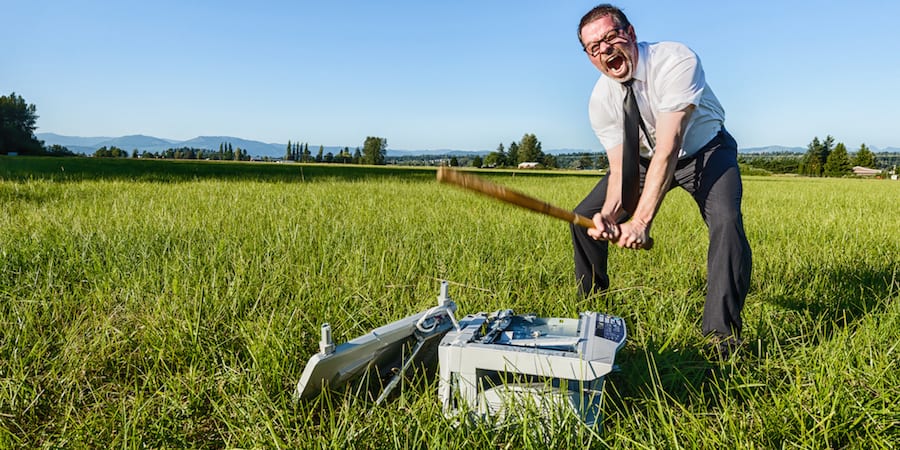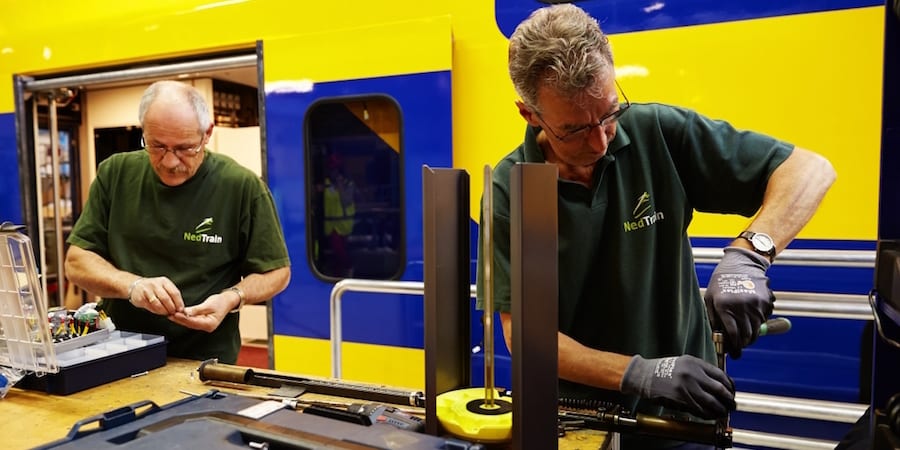
Lean and sustainable fashion meet at Eileen Fisher
FEATURE – Designing beautiful work helps design beautiful clothes. Here’s the story of how women’s clothing brand Eileen Fisher found in lean a way to support its environmental sustainability strategy.
Words: Johanne Read, Manager of Product Development, and Tess De Mesa, Technical/Quality Controller, Eileen Fisher; with Alice Lee, Executive Director, Strategy and Administration, Lean Enterprise Institute
Lex Schroeder contributed reporting
Eileen Fisher has had a strong focus on sustainability since its founding in 1984 in a loft in Tribeca, in New York City. As a women’s clothing brand, we strive to make garments that are timeless in style – our products are known for their simplicity – and durable.
Our strategy is outlined in our Vision 2020 pledges, which include only using organic cotton and linen, becoming carbon neutral (in fact, carbon positive), and reaching one million recycled garments by the end of this decade. Indeed, our vision of the future has everything to do with eliminating waste, which comes in many forms: energy consumption, products ending up in landfills, the unnecessary use of resources and raw materials, and so on.
With our commitment to waste elimination, it is perhaps no surprise that we have started to look into lean thinking as a way to streamline our processes and support our environmental and business strategy.
But let's go in order.
CUSTOMERS LIKE RECYCLED CLOTHES
About seven years ago, we opened a store near our offices in Irvington, New York. We called it the Lab Store because we wanted it to be a testing ground for new ideas. One of these ideas was to sell previously owned Eileen Fisher garments. We tested it, and customers loved it – reflecting the growing trend of vintage fashion and proving that our garments don’t go out of style.
Building on the success of that first experiment, the company launched a recycling program, open to employees and customers alike – we called it Green Eileen.) We put the call out by means of a huge ad campaign telling customers “We’d like our clothes back, thanks very much”, inviting them to give back gently-used Eileen Fisher garments for a $5 credit and to support a good cause – the profits from our resale program are donated to support women, girls and the environment. This, too, was a resounding success and, over time, we filled three or four warehouses with used garments people had given back.
We quickly found that we could only sell about half of the clothes we received, because even after washing, ironing, steaming and hanging, many still have stains or tears that needed mending. Committed to not sending any Eileen Fisher garments to landfills, we realized we needed to find a way to scale up and manage this increasingly complex process. Our take-back program now encompasses renewal and reuse initiatives and has grown into an entire department within the company. We are growing our successful resale business, selling garments that are ready for a new home and continuing to donate the profits of those sales to causes we support. For the remaining garments that need some extra love, we are renewing them by mending them or over-dyeing them. Garments that need even more attention are used as the raw materials for entirely new designs. Our Remade collections are iconic Eileen Fisher designs, made from returned Eileen Fisher clothes. We even save all the scraps and the garments we still don’t know how to remake, because one day we plan to be able to regenerate these materials into new yarns and fabrics that are used to make brand new first life garments.
As part of our commitment to a circular business model (and keeping our clothes out of landfills) we opened up our very own Tiny Factory, in the Trent Building in Irvington, NY where our recycling center was already housed. At the Tiny Factory we support our recycling initiative by remanufacturing the garments that we deem too flawed to resell and turning them into our coveted, one-of-a-kind Remade collections. We want this space (including our recycling center, Remade design studio and Tiny Factory) to demonstrate what a zero-waste, “circular economy” looks like in practice. (This circular initiative and story will be on display this Fall during a series of special Eileen Fisher pop-ups hosted by Nordstroms).

WHAT ABOUT LEAN?
This story is a perfect example of how lean thinking can support a company’s environmental sustainability goals.
At Eileen Fisher, we took our first lean steps in September of last year, when Alice Lee and Jeff Smith of the Lean Enterprise Institute were invited to join us for a few days as we tried to figure out how to structure the work we were expanding in the Trent Building, which we were still renovating. (We had seen the potential of lean thinking during a visit to Legal Sea Foods, one of LEI’s co-learning partners.) When we started our work together, it seemed like we were speaking two different languages. At Eileen Fisher, “waste” is usually used in environmental terms, whereas lean folks typically refer to waste in terms of human effort, space, capital and time… but we quickly discovered that we were actually talking about the same things, and that our visions aligned perfectly. We both want to create the most value and the least waste.
Our priority for our new space in the Trent Building was to retain the flexibility to adjust to our changing needs. It didn’t take long for us to see how complex designing the flow of our operation areas was going to be because we can’t plan what kind of (or how many) donated garments are going to come our way until we see them week after week. Our processes would need to take this unpredictability and variability into account. Cynthia Power, the Facilitating Manager of our take-back and reuse program, put it well: “In order to transition to a circular economy model, we’re going to have to change processes many times over. That’s just a given. Lean thinking gives us a way to do that through experimentation.”
But that’s the big vision. The short-term goal was for us to work with LEI to optimize the flow and layout of our new operations in the Trent Building to reduce the lead-time from product concept to sale. The more donated garments we can process, the greater our contribution towards our sustainability goals.
Our Remade work is rather complex and involves several steps: we need to sort (by size, color, fabrication, etc), deconstruct the pieces, iron them, lay them up for cutting, pin the patterns so they can be cut, and find the most efficient and effective way to sew them throughout the production line.

One of the first discussions with LEI focused on whether the laundry service vendor should come once a week or more frequently. The once-per-week pick-up and drop-off was causing headaches, as piles of laundry (up to 2,500 pieces) waited all week to be cleaned and batches of clean laundry would arrive at the same time the dirty ones got picked up. We were experiencing unnecessary peaks of work and bottlenecks in a space that became crammed each time a delivery arrived. We then followed Alice’s recommendation to move past batch-and-queue and embrace single-piece flow, moving to two pick-ups per week and smaller batches. It made our lives so much easier.
During our week with LEI, we also mapped out every step of the process for a single garment (from customer return to Remade production) using a value stream map, which helped us to understand our work differently. After physically walking the space and making the work visual, we realized there were different ways the larger operations of the Trent Building could flow in the future: in one map, the priority was placed on the store and reselling garments, while another version focused on the work of creating Remade items.
We decided to start with prioritizing the new factory and Remade garment product. But reconfiguring the space for the production of Remade items would not have been as easy without understanding all of the elements of our work and developing enough flexibility in our process and special layout to rearrange things to meet our changing needs. During our time together, when our focus was still on using the Trent Building to produce TK pants (a customer favorite) for our main line, Alice and Jeff taught us how to use an operator balance chart to redistribute and balance the work across the sewing cell. That’s also when we made the critical decision of putting the sewing machines on wheels, which allows us to change the sequence of the work as inputs change (something we predicted would happen frequently when we got into Remade product production). Now we can implement one-piece flow any time, no matter what we need to produce.
Observing the work revealed more and more opportunities to redesign the process for greater flow, which in turn led to a number of small kaizens: for example, placing the often-used black thread in the top shelf next to each working station or tying a pair of scissors to each sewing machine with a piece of elastic to avoid the need to get up and down, or search for misplaced scissors.
It became clear how small adjustments in one area have a positive effect down the line, reducing the effort other team members have to make and therefore the total amount of time it takes to make a garment. Lean thinking taught us how to work together as one unit, where we produce one complete, excellent piece, and then another, and then another. It helped people to align towards a common goal by showing how the work of each of them impacts the rest of the operation. When we launched the production line at the Tiny Factory, we were amazed to see our tailors and pattern cutters starting to collaborate more closely: they began to come to the rescue of struggling colleagues, recognize their contribution and really working as a single team.
Once you experience lean, you can’t stop thinking about how to make the work better and easier. This way of thinking quickly starts to permeate everything you do. It unleashes your creativity and develops your ability to solve problems.

CLOSING THE SUSTAINABILITY GAP
At a recent talk at the Smithsonian Design Museum, our founder Eileen said: “We think of ourselves as a circular economy, and we take responsibility for the whole life cycle of our products – from the seeds that grow our cotton to the upcycling of a garment. We say that we grow clothes, we grow people, and we grow business for good.” This sounds pretty lean to us, and we are sure that the methodology will continue to support our vision into the future.
To push sustainable fashion to new heights, however, we will need to find ways to build, maintain, document and communicate sustainable processes – of which the work we did in the Trent Building, at our recycling center and our Tiny Factory, is a perfect example – both within Eileen Fisher and elsewhere. Lean is looking like a way to help us continue to attain our ambitious sustainability goals.
Like in so many organizations, people at Eileen Fisher care deeply about the work they do. To us, a fulfilling day involves setting ambitious goals with team members, learning what’s possible for our industry (which badly needs a redesign of its own), and figuring out ways to improve. We are committed to moving towards a more sustainable future where everything we make is used for as long as possible and eventually recycled and remade. We are modeling what our work looks like in real time so that other companies can get on board and find ways to make their own work lean and circular. At the end of the day, that’s as elegant a thing as the most beautifully constructed garment you can imagine.
THE AUTHORS
Tess De Mesa is Technical/Quality Controller at Eileen Fisher


Read more


FEATURE – A broken phone or a clock showing the wrong time may seem small details to you, but they actually make people's jobs more difficult. Fixing these issues improves work and boosts morale... It also says a lot about you as a company.


FEATURE – Faced with long lead-times to hire new people and with tens of millions paid in sick leave every year, the HR department of Dutch railway operator NS has turned to lean thinking to set them on the right track for the future.




CASE STUDY - What does having a new “true north” mean? Following the merger with a large group, cancer center IOV is looking to seamlessly spread its lean management system to new operations and facilities.

